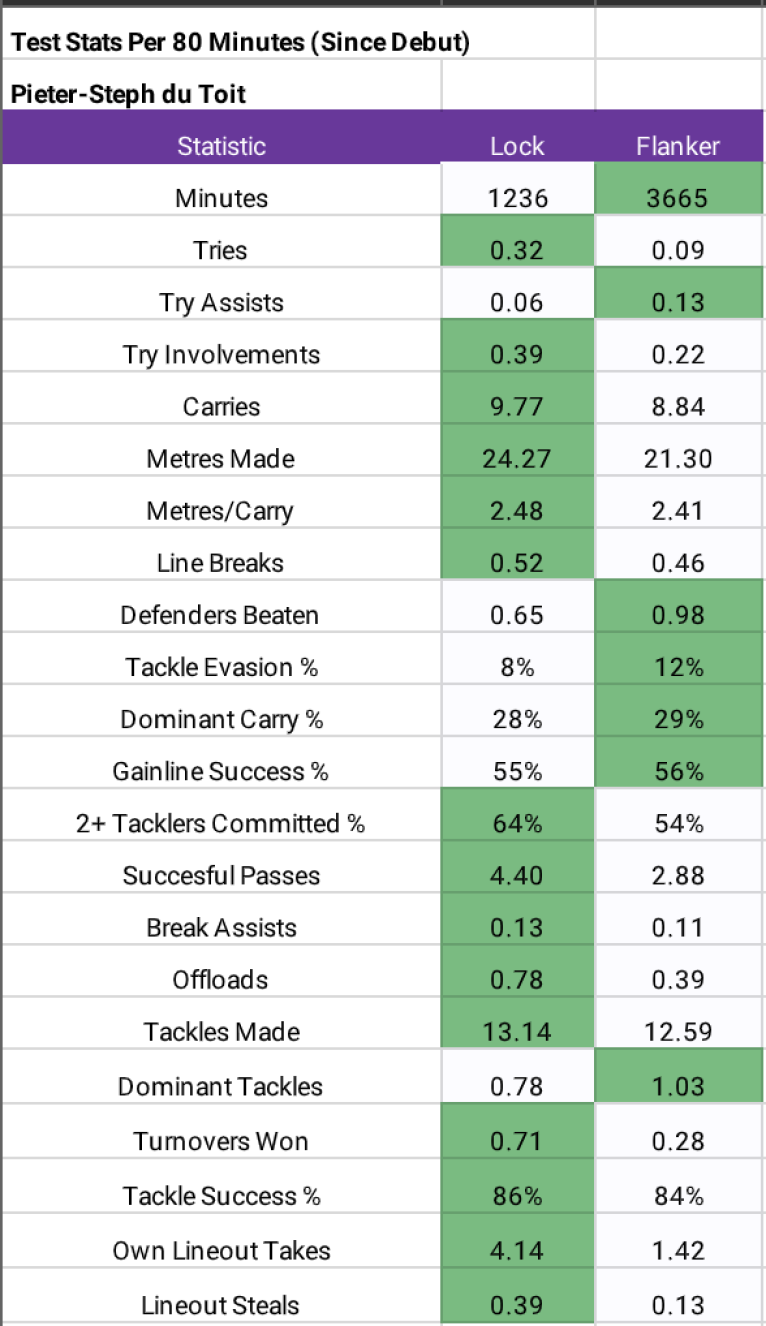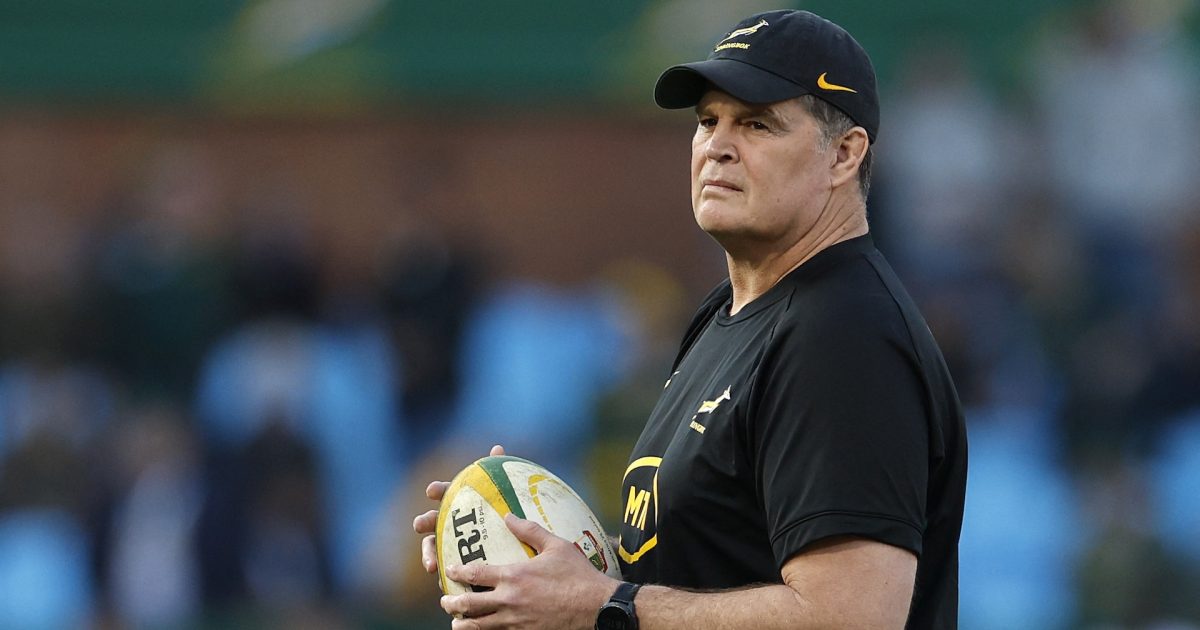Out of a crisis, Rassie Erasmus has unlocked a new Bok cheat code

It is common knowledge that crises create opportunities. And thanks to a staggering spate of injuries in the Springboks’ second row, the chance for something truly transformative has been presented to Rassie Erasmus.
South Africa’s coach once again parted with convention at a press conference this week when he sat at the top table of a media briefing with his laptop at the ready. On the screen in front of him was a list of names which he read out.
“Salmaan [Moerat] is out, Jean Kleyn we know, RG [Snyman] is out for six weeks, Lodewyk [de Jager] is out, Franco [Mostert] is out,” Erasmus stated before including Eben Etzebeth’s name who was not originally selected for this weekend’s match against the All Blacks.
Etzebeth has since recovered, completing a “miraculous” recovery as Erasmus termed it, and will start on the bench. Even so, five locks, four of them with World Cup winners’ medals and a combined 183 Test caps’ worth of experience will be absent for a game that still ranks as the top scalp in the minds of most South African supporters.
But through the gloom a beam of light emerges. Not a beam of light, but a rocket. A rocket with a name. And should that rocket fire on all cylinders, we could see another evolution of this Springboks outfit under Erasmus.
Pieter-Steph du Toit, also known as the Malmesbury Rocket after his home town, is already a Springboks great whose reputation has passed into folklore. Named as World Rugby’s player of the year after lifting the 2019 World Cup, he then bagged a British and Irish Lions series gong before overcoming a life threatening injury. Then, with his father’s hamstring tendon surgically implanted into his left leg, he won another World Cup having made an astonishing 28 tackles in the final.
Now South Africa’s best loose forward of all time is being asked to do a job in the second row. This is not alien territory. His very first senior game – in 2012 for the Sharks in the Vodacom Cup – was with the No4 on his back. When he took his first steps in Super Rugby it was at lock and when he made his debut for his country, he replaced Etzebeth in Cardiff in 2013.
But du Toit’s athleticism, his insatiable desire to hammer every ruck, and his unending quest to shatter rib cages in broken play meant that a switch to the back row was inevitable. He played there for the South Africa u20s in the triumphant World Cup in 2012. And though it wouldn’t be until 2017 that he started most games for the Springboks at blindside flank, he has since owned the No7 jersey.
Fast forward seven years to an injury crisis in the second row and du Toit was asked to reprise an old role for the first Test of the 2024 Rugby Championship. The late withdrawal of Snyman ahead of the clash with the Wallabies in Brisbane saw du Toit move deeper into the pack.
Did this dilute his dynamism? Not a chance. He carried twelve times for 86 metres, beat two defenders, made 15 tackles and stole one turnover. He was a flank in lock’s clothing but also secured a line-out and pinched one of Australia’s throws. The number on his back scarcely seemed to matter. And therein lies the cause of so much excitement.
Du Toit has played a total of 1,236 minutes as a lock for South Africa, which is a quarter of all his minutes in Test rugby. While in the second row he averages more carries per game, makes more metres per game, makes more carries per metre and has more line breaks per game.
He averages more than twice as many successful passes per game from the second row, makes more offloads and creates more line-break assists. He also has a higher tackle rate. Most surprisingly, when he plays in the second row he causes 0.71 turnovers per 80 minutes of rugby compared to the 0.28 he manages from flank. He also scores three times as many tries per game in his so-called second position.
Of the 21 metrics examined [see table], du Toit puts up better numbers at lock than he does at flank in 15 of them. Evidently the argument that his powers might be diminished pushing scrums and mauls doesn’t hold up.
But what about other Test hybrids? Does anyone else lean so heavily towards the unexpected? Scott Barrett and Maro Itoje have each spent less than 10% of their time in Tests at flank, and Christ Tshiunza has only played ten Tests in total, so their numbers are negligible.

Instead we’ll look at four players who have spent most of their time at lock but have considerable experience at flank – Mostert, Ryan Baird, Tadgh Beirne and Cameron Woki – as well as Marcos Kremer, who primarily operates in the back row but has on occasion stepped into the tight five.
Apart from Mostert – who we’ll get to in a moment – all of the above players offer more per game when playing flank. They tend to carry more regularly and more effectively, make more tackles, get over the gainline at a higher frequency and offer a more conspicuous presence. Perhaps this is simply a statistical quirk or perhaps they are given more licence to roam when not sucked into the morass of the tight five.
Mostert, though, is the outlier. Like du Toit he puts up better numbers at lock than he does at flank. Gainline success, successful passes per game, tackles per game and tackle success rates are all up when Mostert occupies the second row. Maybe this suggests that the Springboks’ tighthead lock is afforded the freedom to play an expansive game, acting as a genuine bridge between the tight five and the rest of the pack.
Whatever the reason, the selection of a hybrid at five allows Erasmus to effectively game the system and pick four loose forwards for the price of three. As he demonstrated at last year’s World Cup, when he backed Deon Fourie to play as a back-up hooker, he is willing to sacrifice clean ball at the line-out for more dash and daring in open play. As the Springboks gameplan quickens, and as the attack evolves, having the world’s best flank in the second row might start to feel like a cheat code.








































Malmesbury Missile.
And yes. We know. He’s amazeballs.
Also weakens the lineout. PSDT is a good lineout jumper but having the extra lock forward means SA has 3 world class lineout jumpers rather than 2. Unfortunately this week we only have 1 as Nortje and BJD are unproven at this level. Bit nervous for the scrum as well which benefits from the heft and power of an extra class lock like a Kleyn, Snyman or Mostert
Hulle weet nie wat ons weet nie.
Go Bokke, go PSDT, gee hulle horings
The stats are super interesting.
Superb analysis and real insight from this report. It really does pose the question on why his numbers are even better at lock than br, but I’m pretty sure Rassie already knows the answer…
World Rugby already drafting a new set of rules to outlaw the practise.. 😅
Wouldn't surprise me a bit
The question is why are so many bok players injured? My theory is they needed more time off post world-cup and post the various league playoffs
Yes, and look at the Aussies two weeks ago as well. Worrying, but at least the head injuries seem to be going down, and watching the Bok tackling you can hopefully see why. But then that's maybe why they're getting more injuries!